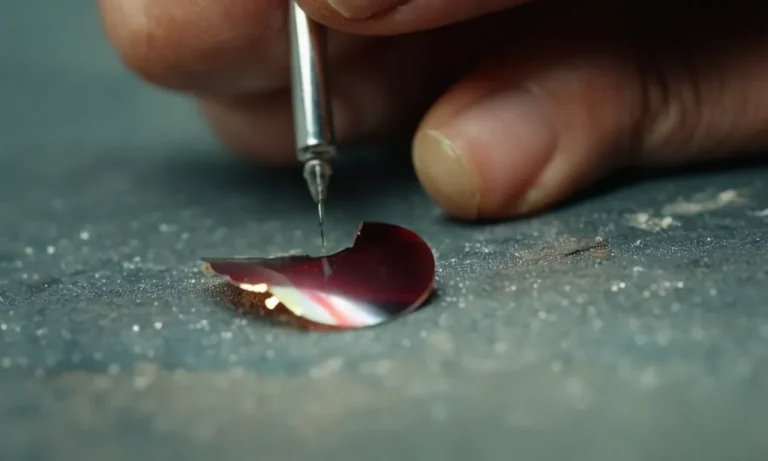How Much Does Nail Tech School Cost? A Detailed Look At Programs, Tuition, And Getting Certified
So you want to become a nail technician? Great choice! Helping clients look and feel their best with a manicure or pedicure can be an incredibly rewarding career. But before you can start polishing and pampering, you need proper training and certification.
In this comprehensive guide, we’ll walk through everything you need to know about attending nail tech school, including average costs, curriculum, certification requirements, financial aid options, and tips for choosing the right program.
If you’re short on time, here’s a quick answer: On average, nail tech school costs between $4,000 and $7,000 for a basic training program. However, costs vary widely based on the school, program length and location.
Nail Tech School Overview: A Quick 101
What Will I Learn?
Nail technician school teaches you everything you need to know to start a career as a licensed nail tech. The curriculum covers nail structure, nail diseases and disorders, sanitation and infection control, state safety laws, customer service, basic manicures and pedicures, nail enhancements like acrylics and gels, nail art, business skills, and more.
You’ll get hands-on training in the student salon to build your technical skills.
What are the Steps to Becoming a Nail Tech?
Here are the main steps to becoming a licensed nail technician:
- Graduate from a state-approved nail tech program – Most are between 300 to 600 hours.
- Apply for your state license by passing written and practical exams.
- Research your state’s license requirements and renewals.
- Apply for jobs at salons or consider opening your own business.
How Long Does It Take?
A full-time nail tech program takes 3 to 6 months to complete. However, many schools offer part-time schedules that extend the duration. The total program hours range from 300 to 600 based on your state’s requirements.
What is the Cost of Nail Tech School?
Nail technician school costs between $4,000 to $10,000 on average. However, prices vary by location, school, and program duration. Here are some of the main factors that impact the total tuition:
| Factor | Typical Price Range |
|---|---|
| Registration/Application Fees | $50 – $150 |
| Tuition | $3,000 – $8,000 |
| Books & Supplies | $500 – $2,000 |
| Licensing Exam Fees | $100 – $300 |
Many nail schools offer flexible payment plans, scholarships, and financial aid options to help students cover costs. Overall, nail technician school provides an affordable entry point into a rewarding beauty industry career.
Detailed Breakdown of Nail Tech School Costs
Tuition Fees
The tuition fees for nail technician programs can vary greatly depending on the school, program duration and location. On average, tuition ranges from $4,000 to $10,000 for a basic manicurist program lasting 3-9 months [1].
More comprehensive programs that include advanced techniques like nail art and extensions can cost $10,000 to $20,000 [2]. Community colleges and trade schools tend to be on the lower end while private beauty schools are more expensive.
Additional Expenses
On top of tuition, expect to spend $500 to $3,000 on exam fees, textbooks, uniforms, nail kits and other materials. For example, a professional nail kit with quality tools like electric nail files, UV lamps and acrylic powder can cost around $1,000 alone.
You may also need liability insurance which runs $100+ per year [3].
Cost Comparison of Different Programs
| Program | Duration | Tuition | Extras | Total Cost |
| Community College Certificate | 3-6 months | $3,000 | $1,500 | $4,500 |
| Private School Diploma | 6-9 months | $8,000 | $2,500 | $10,500 |
| Advanced Nail Technician Certification | 9-12 months | $15,000 | $3,000 | $18,000 |
As shown, costs increase for longer programs at private schools, especially those covering specialties. However, advanced programs lead to higher earning potential, with top nail techs making up to $85,000 per year [2].
Financial Aid Options
Many nail tech schools offer flexible payment plans to split costs over time. Federal student aid like grants and loans may also be available at accredited schools and programs.
Some state governments provide workforce training funds and scholarships for fields facing labor shortages like nail technology. And organizations such as Beauty Changes Lives award over $300,000 in scholarships to aspiring beauty professionals each year [4].
So while nail tech school is a significant investment, there are many affordable programs and financial assistance options to explore.
How to Choose the Right Nail Tech School
Accreditation
When selecting a nail technician program, one of the most vital aspects to consider is proper accreditation. Favor schools accredited by organizations like the National Accrediting Commission of Career Arts and Sciences (NACCAS). This ensures the curriculum satisfies industry standards.
Graduating from an accredited nail program is also required to take the state board exam for licensing in most states. Double-check your state’s specific prerequisites to guarantee the program complies.
Curriculum and Specializations
An exceptional nail tech curriculum should encompass both theory and practical training on topics like nail structure, diseases and disorders, manicures, pedicures, waxing, chemistry, sanitation practices, and business skills.
Many programs allow students to specialize in areas like advanced nail art or massage therapy for better career preparation. Ask schools about the curriculum framework, specialized electives, and certifications offered to pick the best match for your interests.
Location and Schedule
Optimal location and class schedules differ among students. If you’re working while in school, consider proximity to your job and programs offering night or weekend classes. Online or hybrid nail tech programs also provide incredible flexibility though may limit hands-on practice time.
Determine location and time preferences before touring school options.
Student-Teacher Ratio
| Student-Teacher Ratio | Benefits |
| Lower ratio (under 20:1) | More individualized attention and instructor guidance |
| Higher ratio (over 25:1) | Potentially lower program costs |
While one-on-one instruction has advantages, a higher student-teacher ratio doesn’t necessarily equal poor training quality. Assess your learning preferences and budget to decide which works best.
Salon for Practical Experience
The best real-world practice comes from working on genuine clients, not just mannequin hands. Search for schools partnered with student salons or clinics. This is where you’ll refine skills in a spa-like setting under instructor supervision.
Some states mandate completion of practical training hours before allowing licensure exams. Salon experience also permits you to build clientele and professional confidence.
Earning Your Nail Tech License After Graduation
Understanding Licensing Requirements
After completing nail tech school, the next step is to earn your nail technician license. This involves meeting the licensing requirements for your state and passing exams. Here’s what you need to know:
- Licensing is mandatory – you cannot work as a nail tech without a current license issued by your state’s cosmetology board.
- Licensing requirements vary by state but generally involve being at least 16 years old, completing an approved training program, and passing written and practical exams.
- Some states require a high school diploma or GED before applying for a nail tech license.
- Application fees, exam fees, and license renewal fees differ by state. Expect costs of $100-$300.
Passing the Written and Practical Exams
To qualify for a nail tech license, you must pass a written test and a hands-on practical exam. Exam details include:
- The written exam covers nail structure, diseases, procedures, tools, chemistry, and state regulations. Multiple choice format with around 100 questions.
- The practical exam evaluates your technique on skills like manicures, pedicures, acrylic/gel nails, nail art, and sanitation. Time limit of 90-120 minutes.
- Most states use exams from the National Interstate Council of State Boards of Cosmetology (NIC).
- Passing score is typically 70-75% on each section.
- You can retake failed sections after paying exam fees again.
Thorough exam preparation and nail tech program training helps ensure you pass on the first try.
Renewing Your License
Nail tech licenses must be renewed periodically to remain valid, generally every 1-2 years. Renewal requirements typically include:
- Paying a license renewal fee to your state cosmetology board.
- Completing continuing education credits – common renewal requirements are 4-12 hours of training.
- Some states mandate CPR training as well.
Failing to properly renew your nail tech license on time can result in penalties or having to completely reapply and retake exams.
Reciprocity Between States
With a current nail tech license, you can work when relocating to another state by transferring your license. This is known as license reciprocity or endorsement. Requirements for reciprocity include:
- Submitting an endorsement application and paying fees to the new state’s cosmetology board.
- Meeting that state’s licensing requirements, like age, training hours, exams, etc.
- Some states have reciprocity agreements and offer license transfers more easily.
- If licensing requirements differ dramatically, you may need to take additional exams.
Starting Your Nail Tech Career
Job Options for Licensed Nail Technicians
There are many exciting job opportunities for newly licensed nail techs. Many choose to work at nail salons, either as an employee or independent contractor. Salons allow you to build up your skills and clientele. Retail stores like salon chains and spas also employ manicurists.
Or you can be your own boss by renting a salon suite, opening a home salon, or visiting clients as a mobile technician.
Some nail techs specialize in natural nail care and consult with clients on nail health. Others provide sculpted extensions like acrylics or dip powder nails. With experience, you can offer advanced services like nail art designs. Many techs enjoy the creative outlet nail art provides!
You may also find jobs doing manicures on sets for TV, movies, fashion shows, or print ads. Or put your customer service skills to work as an educator for a nail product company. With hard work and persistence, you can build an amazing career as a licensed nail technician.
Building Your Skills and Clientele as a New Tech
When first starting out, focus on building up your technical skills and establishing a loyal client base. Take advanced classes to expand your service menu. Shadow experienced techs to refine techniques. Volunteer to do friends’ or family members’ nails for practice.
To attract clients, promote yourself on social media and deal sites like Groupon. Offer discounts for first-time or referral customers. Provide excellent service and be consistent with appointments to retain clients. Join local networking groups to meet professionals who may become customers.
With dedication, your reputation and clientele will grow.
How Much Do Nail Techs Earn?
Income for nail technicians varies based on factors like location, salon type, and experience level. Many new techs earn $20,000 to $30,000 per year, with top earners making $50,000 or more. The average salary nationwide is around $27,000, according to PayScale.
Nail techs working in high-end salons and those with large clientele tend to earn the most. Metropolitan areas also pay more than rural locations. With each year of experience, you can increase your earning potential.
Many nail techs earn money through tips as well. This extra income from gratuities can add tens of thousands of dollars to your annual salary. Provide excellent customer service to maximize your tip earnings.
Conclusion
We hope this guide gave you a comprehensive overview of what’s involved in attending nail tech school. The investment in tuition and time will pay off with an exciting, hands-on career helping clients look their very best.
With proper training from an accredited program, passing your exams, and building up your professional skills and clientele, you’ll be well on your way to a rewarding profession as a licensed nail technician.







